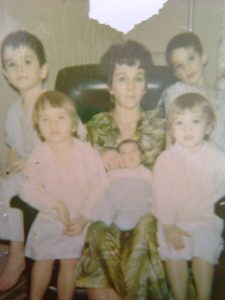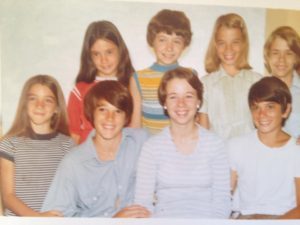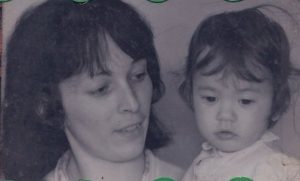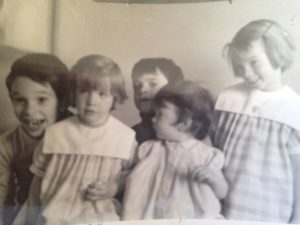A 1960s Housewife Cleaning Routine
I grew up with a stay-at-home 1960s housewife in a house that was always spotless, to the point that people called my mom “the white tornado.” If I recall correctly, this was at the time of those Mr. Clean commercials where the tornado came through and cleaned the house and then the tornado stopped spinning and it was Mr. Clean. My mother, they claimed, was even better at keeping house than Mr. Clean. Even with a husband away in the military and a house full of kids (usually 5, but always at least 8 on the weekends), she got it all done every day. So how did she do that? Inquiring minds wanted to know, so I interviewed mom. Here’s what she had to say about her daily cleaning routine.

Me: Mom, how old were you when you first got married?
Mom: I married in 1961, when I was 18 and I had my first son in May of 1962. Of course, my husband was in the military so it was a challenge in the beginning. I found our apartment on my own and furnished it while he was away. Then he came home on leave and that resulted in my second son coming along in December of 1963.
Me: That sounds like a lot of work for a military wife, all alone. Did you have help from extended family?
Mom: No. I didn’t. I was actually also cleaning my own mother’s house at the same time. She lived across the street from me.
Me: My readers will need to understand that eventually those long separations and the strain of being alone caused some changes in your life. You inevitably divorced Sean Sr. and then married my father, Don.
Mom: Yes, and Sean re-married as well. But we all stayed very close, for the sake of the children.
Me: And dad had some children from an earlier marriage?
Mom: Yes. Three. And then we had three more of our own.
Me: Give us one example of the type of preparation you speak of.
Me. Yes. I was the youngest of 8 that were regularly in our home including– Sean, Carol, Kelly, Paul, Tracey, Wendy, Laurie, and me. And there was also Lisa and Francis from Sean Sr’s second marriage who would eventually spend some time with us as well. How on earth did you manage with so many children?
Mom: Preparation, organization, and team work. I started teaching the concept of teamwork to all you kids as soon as you were old enough to help. I figured if you could manage to take your clothes off at age 2, even when you weren’t supposed to, then you could certainly figure out how to get them in the hamper. And even the youngest of children can help match socks. So everyone learned early.

Mom: Okay. One example, our house at the time had two floors. The second floor had all the bedrooms and the bathroom. Every morning when we woke up, the older kids made their beds and brushed their teeth and got dressed into the clothes we laid out the night before while I cleaned and changed babies.
I had a changing table on the 2nd floor already set up the night before with all the babies’ needs–cloth diapers, fresh clothes, etc. I also had a matching changing table downstairs already prepped with everything they would need during the day. I prepped both the night before at the same time that we prepped the next day’s school clothes for all the kids.
While I finished getting the smaller children ready, any dusting that needed to be done in the bedrooms was done by the older kids (whoever had that chore that week).
Only after everyone was changed and ready for the day would we go ahead downstairs for breakfast. Once downstairs, no child had any reason to go back upstairs for the entire day, except to use the bathroom, so that area of the house stayed very clean.
Me: What about the children who were too young to make their own bed or get dressed themselves?
Mom: As I mentioned before, I spent many years alone with the kids while my husband(s) were away in the military. During that time we adopted a spirit of teamwork. Everything we did was about team work. The older kids would help with the beds of the younger ones. Then as soon as a youngster was able, they would learn with the help of an older child–each doing one side of the bed. And eventually the little ones would do it themselves. Even if the work wasn’t perfect, it was okay. It was about the effort, and it was about participating with the rest of the family. This usually makes the little ones feel very good–to do their part. Everyone wants to feel like they contribute and are part of something.

Me: But what about toys? How did we get to those if we couldn’t come back upstairs all day?
Mom: The only things in the bedrooms were beds, bureaus (Note: those are “dressers” to all of you non-French Canadian readers), 2 small toys or stuffed animals per child, and lots of books. There was no reason to keep anything else in there. Those rooms were for sleeping only. We had a play area downstairs for toys. But even then, you have to realize that we didn’t have a lot of toys. We had Barbies and GI Joes, yes. But mostly we had different activity boxes. Each box held certain activities such as coloring books and crayons, or paper and scissors, or things like that. We took one activity box out at a time for projects. And that mess had to be cleaned and put away before any other toys or activities were taken out.
This method served two purposes. We would do things that took quite a bit of time and used the kids’ imaginations. This kept them busy and kept them learning. We didn’t own a Barbie house, but we made many through the years. And it would take you kids all morning to build your Barbie town and you’d play with it all afternoon and into the evening. Or your brothers’ GI Joes would come destroy it. :::laughs::: Nobody was ever bored.
Me: That brings two more questions to mind. I’ll start with this. What did you do with the babies all day while these projects were going on?
Mom: Gates. I relied on lots of gates to keep toddlers safe and in the same area as me throughout the day. But if we were cutting paper, the toddlers had paper to tear up too. If we were making cars out of boxes, the toddlers had boxes to play with too. Everything was team work, starting at the youngest of ages.

Me: And my next question. How did you handle it when one child didn’t want to do what everyone else was doing? Or was acting out? Certainly not all projects went smoothly?
Mom: If any of the kids wanted to read or go outside and play instead, they could. But if we were dragging out a project, that was the playing option for that time. Parents cater too much to children these days. They let them rule the house. That creates many problems and it does nothing to prepare children for when they will have to conform to school activities. It was “play this, or go outside.” That’s it.
Me: And what about discipline?
Mom: Most of the time I was able to manage with sitting an unruly child in a chair in front of me for a time with his/her arms folded. Usually it would be 5 minutes. I’d tell them why they were there and then when the time was up they had to tell me why they were there. If they even spoke a single word during the five minutes, we added 2 more each time. And if they refused to tell me why they were seated there, they would stay in the chair until they did. That didn’t alway work, but more often than not it was enough. And when it wasn’t, we used good old-fashioned discipline methods that are not popular today, but certainly were accepted and very effective then. I kept a nice supply of wooden spoons, but these were reserved for the older kids who dared to refuse to comply.
Me: I am happy to say that was never me. Anyway…back to cleaning. Tell me more about some of your routines that you had in place.
Mom: Oh. Let’s see. (pause) For the diapers–we used all cloth diapers back then– I had a great routine that kept things manageable. I never had buckets full of dirty diapers because I would take care of them immediately. We had a double sink in the kitchen and one side was very deep. I kept that sink open throughout the day so that I could immediately wash diapers and hang them right after changing and settling the baby back in. Only very dirty diapers were soaked in a bucket of bleach water, and never for more than an hour or so before taking care to wash and hang those too. Once you are into the routine, it just adds a couple more minutes on to each diaper change and you never had to worry about the stench of dirty diapers stacking up in the house or having to wash a mountain of disgusting mess. They were always done. This also kept me from having to buy dozens of diapers. If you are cleaning them all the time, there is no need.
It worked the same way with dishes throughout the day. All were washed, dried, and put away immediately, by me and the children. Our everyday dishes were unbreakable so that all the children could take part in helping with meal prep and clean up. Again, it’s that teamwork thing. If possible, kids helped prepare lunch, and then we all cleaned up. As soon as a child was able to hold a towel, they could help dry their own bowl. Maybe not always perfectly, but I’d let them try then tidy it up a bit more as I put it away. All meals were handled this way.
Me: And none of us complained?
Mom: There was occasional moaning, but you all knew you didn’t have an option. Everyone who makes messes cleans messes.
Me: Ah. Good rule.
Mom: I learned early on the value of: “Say what you mean and mean what you say.” If a child was acting up and I threatened to put them in a chair, I learned that I’d better follow through every single time or they would learn that they could act out and get away with it. So consistency was key. And you all learned that if I said it, I meant business.
Me: Tell us more of your routines.
Mom: Laundry was another big one. With 7 to 10 people in the house every single day, there was never a shortage of that, so I had several systems in place to keep it under control. It would start in the morning with bed making. One child each day would strip his or her bed and put the sheets in the laundry. We had a schedule for that because we had so many beds to keep up with. We also had a bath towel and a hand towel labeled with each child’s name. Those hung on hooks in the bathroom. You were responsible for making sure that your towels were hung on the hooks, and not left on the floor. The younger children had lower hooks. Starting at age 3 or so, they were more than capable of hanging their towels, and I was there to help them figure it out. This set them up for the later years. If anyone didn’t hang theirs, they got to clean other parts of the bathroom too, so there was good motivation to keep them hung up. Face clothes were only used once and thrown into the laundry. Towels were washed 2-3 sets at a time in rotation just like the sheets. Otherwise, I would have had two full loads of just towels every day. And considering that everything had to be hung out on lines, that would have been overload for sure.
Every article of clothing was marked for each child. For items that would never pass down, I’d write the first initial of the child (socks, and underwear, for example.) For items that would pass down by size, I would use numbers. So the oldest would start in number ones. Then those would pass to his brother. And so on. We then we would just keep a chart of which child was currently wearing number 1s or 2’s, and which was wearing number 4’s, etc. Some kids grow faster than others, so it wasn’t always by age. It was always by size. Writing numbers with a fabric marker (before Sharpies) was easier to see than trying to find the size on a worn out tag. This was invaluable when sorting laundry. Once sorted, everyone came to get their pile and put it away. For the little ones, we had pictures of a shirt on the outside of the shirt drawer, and pants on the outside of the pants drawer, and so on. So they could put their own clothes away. Once they learned that they would have to put them away, there was never a problem of a child going and pulling things out of a drawer again.
Me: I remember that. I grew faster than my sisters when I hit puberty and got more of the newer clothes. They didn’t like that. hah!
Mom: And then a year or so after that there were four of us all in the same size. We had to expand and then had a huge wardrobe then. :::laughs::: it was fun.
And also, all throughout the school years, we had clothing designated for school only. You all changed out of those as soon as you came home. And every night after dinner, clothes for the next day, including gym clothes, were laid out so there were no arguments or missing items to hunt for in the morning. Routines, routines, routines. Very important.
Me: I remember when my girls were young and Mr. C was working out-of-town for weeks at a time, I struggled to bring three kids under the age of four to the supermarket. How on earth did you do it with 5-8 kids??
Mom: It was different in the early years than the later years. In the early years a few things were very different from now. First, kids were generally more well-behaved. Respect and obedience were taught differently. Secondly, the market was smaller than it is now. We didn’t have 120 different varieties of cereal or 80 kinds of spaghetti sauce. So, I’d back up a stroller with the baby, which would be pushed by an older child. A toddler was in the shopping cart with me. And the rest stayed just behind me. Walking in line. Behaving for the most part. Shopping was quick because I would have prepared menus for the week and knew exactly what I needed. I never varied from my menus, so no child begged to buy anything. It was simply not done. And to speed things up more, sometimes I would send the older children to find products I needed from different areas of the store. Doing so also taught them early how to shop and find things they needed and kept them from getting bored.
In the later years, once all the children were over the age of six, I changed it up. I would take one child per week shopping with me and afterwards we would go out for a burger and some quality one-on-one time. That was a huge treat back then as going out to eat was not possible with a big family and a budget like ours.
Me: I remember fun burgers from Burger King
Mom: Yes. Before happy meals it was just a “Fun burger” with a toy in it.
Me: Anything else to add to the shopping topic?
Mom: No but I should note that on weekends I would spend an entire afternoon cooking meals, some of which would be reheated during the week for dinner, especially if there were softball games to get to. I’d also prep what I could for lunches for the week, and of course, every night we ate at the table as a family. No t.v. No exceptions.
Me: Yes. I loved that. I managed to do that with my girls right up until Steph moved out.
Me. What else? What other tips and tricks did you use?
Mom: One of my favorites was the cardboard clocks. We had them in the bedrooms so that we could show the little ones what time it had to be before they could come wake me up. This was great on the weekend. We would have a cardboard clock set to 6 a.m. on the side of the regular clock. They would have to wait until the little hand was at least on the six. It worked well.
Another was my emergency car kit. I kept a kit in the trunk that had glass jars full of water, cans of fruit cocktail and other prepared foods, changes of clothes. Anything I could think of that we might need if we ran late or got stranded anywhere. That kit saved me thousands over the years in fast food we never had to buy. On a tight budget, that was important.
Me: What were your go to cleaning products?
Mom: Ajax powdered soap, with borax or baking soda for the laundry. Bleach was only used to soak diapers. Vinegar for rinsing in laundry. Spic n Span once a week on the floors. (Everyday floor wiping was just vinegar in water.) And my one and only luxury was paper towels in bathroom. With so many kids constantly washing and wiping dirty faces and hands, these saved my laundry pile.
Me: Let’s talk about that bathroom. What were the routines there?
Mom: Well we already talked about the towels, and that’s half the battle. It’s also important to note that we had only a bath tub, no shower until many years later. So it was easier to just clean a tub than to scrub an entire tub surround regularly. I simply did that every night after everyone’s bath was finished. It took just a minute because I did it every day. Toilet and sink were also cleaned every day. And boys who “missed” were taught to clean up after themselves. Of course, the floor was quick mopped daily and deep cleaned once a week with the rest.
We didn’t have carpet in the house. I hate carpet. It’s dusty and dirty and leads to allergies.
Me: Did you ever have any cleaning “fails”?
Mom: Oh yes. When I first married my husband from Ireland he brought with him a stack of the most beautiful Irish sweaters. Wool. I had no idea you could not dry wool in a dryer. And I hadn’t much experience with clothes dryers at all as we almost always hung our clothes on a line. Anyway, I had done a bunch of laundry at a laundry mat and dried all his beautiful sweaters and shrunk them to the size of doll clothes. I cried for months.
Me: Do you have any advice for current day house wives?
Mom: When my children were growing up, our neighborhood was our support system. Moms met up outside when hanging laundry. We had coffee together during breaks. Our children played together. We held each other up, watched each other kids, and were generally there for each other. I understand that things have changed and most moms these days have to get their support on social media. It’s sad. That’s not a great replacement for human interaction and it can easily lead to problems where mom stays on the computer instead of getting her work done or even worse, instead of spending time with her children.
My advice is to set time limits. 15 minutes break after one hour cleaning or playing. Then back to real life. Don’t get hung up in an on line community. You will get lost in there for hours and not get anything done except increase stress and guilt. Go out and find people. Join clubs. Join the Y. Find real people to interact with. And don’t let your kids get too entwined in that artificial world either. Make sure they learn how to interact in person too.
Another thing I would suggest is limiting toys. Kids have too many things and no reason to use their imagination anymore. Those kids have to lead our country someday. We need to make sure that they have developed thinking skills. Rotate toys. Put some away for a rainy day.
And, mom should save the hour after the kids are in bed for herself. Read, take a bath, kick back, enjoy a show. Enjoy it. Don’t clean. Sanity is important too.
Lastly, remember that there are no laws against child labor at home. :::laughs::: I called it becoming self-sufficient. Don’t be afraid to have the kids help. You aren’t torturing them. You are teaching them, and that’s part of your job as a parent. You are enabling them to succeed by showing them community spirit, self-sufficiency, and the importance of routines, organization, and personal responsibility.
Me: Thanks mom. Love you.
Mom: Love you too. Now go clean your room.




